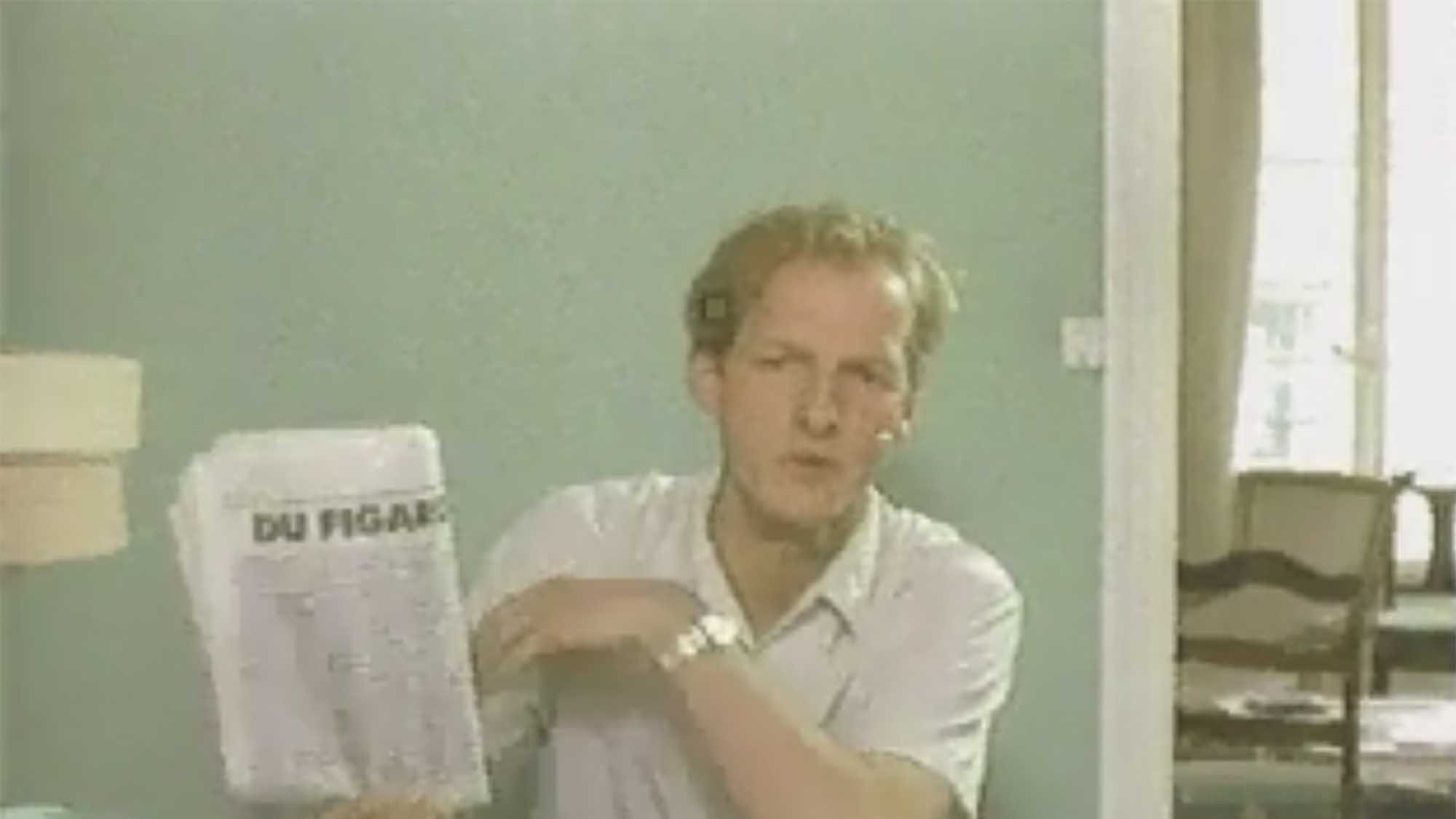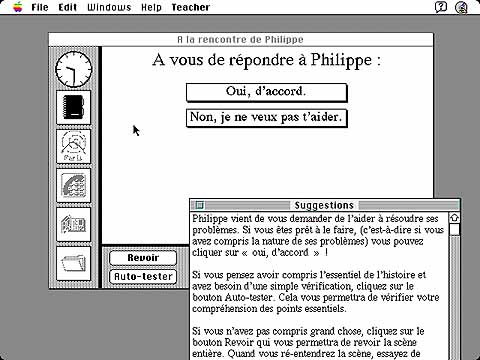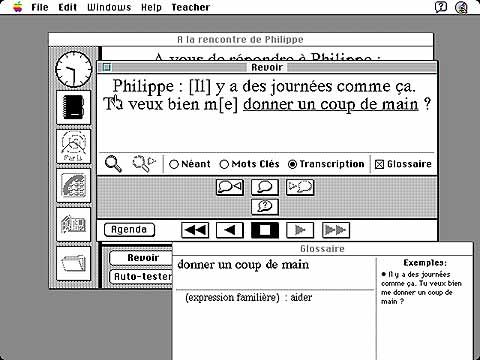A la rencontre de Philippe

A la rencontre de Philippe was created in the mid-1980s out of a collaboration between MIT Foreign Languages and Literatures and MIT’s Project Athena to use newly-emerging computer technology to create innovative materials for language learning. A la rencontre de Philippe was first developed in laserdisc format, and published by Yale University Press in 1993. In 2006, it was released in CD-ROM format by the French publishing Company, CLE International, based in Paris. Both were accompanied by a Teacher’s and Student’s manual (authored by Gilberte Furstenberg). Neither version is currently in print.
Objective
The objective of this program is to create an environment which, through the double process of immersion and interaction, is as close to the natural one as possible: where language takes back its primary function, as a tool for communication, and where the language learning process becomes experiential. The specific goal is to develop the users’ understanding of authentic spoken French by motivating them to understand what they see, hear and read.
Problem
Usually, students have a hard time understanding authentic spoken French as it is fast-paced, difficult to comprehend and the context is often unclear. Plus they lack intrinsic motivation in trying to understand, as there usually is nothing at stake. Here, students are motivated to understand as, in the process of searching for an apartment, they may uncover information that will help them with their task.
Subject
“A la rencontre de Philippe” is an interactive fiction, filmed in Paris, which puts learners in the middle of a story, of which they become the central character. The story branches out in different ways, depending upon what students do, which in turn depends on what they understand. In the process of involving students in a story, “A la rencontre de Philippe” also involves them in the language learning process.
Context
This is the story of a young freelance journalist who has many problems: money problems, job problems and problems with his girlfriend.
Philippe’s girlfriend dumps him
Indeed, when the film begins, we find out that Elisabeth has just thrown him out of the apartment they have been sharing for the last three months.
Philippe quickly needs to find himself another place to stay and enlists the student’s help in locating one. (Click on image to enlarge.)
Thus enters the student. In the process of helping Philippe, students wander through Paris, and with the help of a map,
Philippe shows where he lives.
Philippe shows all of the things the student can use
a newspaper, an answering machine, a telephone and a dossier, will try to find a solution to Philippe’s problems.


A rendezvous with Philippe
Delivery
This program takes a fundamentally different approach from the traditional one: it first immerses the user in a linguistically and culturally authentic world and then provides them with two sets of tools: tools to understand what people are saying, and also (and this is what makes this program unique) tools to function within the story. The tools enabling the user to understand include: the ability to stop the video on demand, to repeat segments, to access key words, a transcription, a glossary, a second audio track, self-test quizzes, etc…
In this environment, students try to understand not for the sake of understanding, but in order to accomplish a task: that of finding an apartment for Philippe. Here, students are constantly and actively engaged and the learning is exploratory. There are no right or wrong answers, only consequences to what they do or do not do. The story and the game quality of the program act as powerful motivators.
Other features
The fiction constitutes the core of the program, but other auxiliary features also exist, that can be used independently. They are:
- the MFI (Multiple Index Functions) which is an instantaneously accessible database of images and video segments arranged according to different categories. This MFI is modifiable by the teacher.
- a video album which allows students to edit the film and create their own collection of images.
- a Visite d’appartements which provides access to eleven different apartment that can be visited and explored.
A la rencontre de Philippe / Meeting Philippe
Gilberte Furstenberg – Principal author
Ayshe Farman-Farmaian – Interactive video producer
Stuart Malone – Software designer
Janet H. Murray – Project director
Carmen Compte – Design consultant in Paris
Sophie Tatischeff – Film director in Paris
Laurent Benegui – Scriptwriter in Paris
Sponsors
Major funding is provided by The Annenberg/CPB Project.
Special thanks
- Sophie Tatischeff, the film maker, for making a beautiful film and for daring a new type of interactive cinema. -
- Laurent Benegui, for writing the script and giving the characters flesh, irony and sarcasm.
- Carmen Compte, for contributing her talent at designing an interactive scenario
Direct all inquires to
Gilberte Furstenberg for information about the design and the pedagogical uses of the program.
Yale University Press for information about ordering.
Availability
The program is published by Yale University Press. A package includes the videodisc, the software and a Teacher’s manual. The students’ manual is available separately.
Audience
The primary audience is high school and college students. Learners of different levels can use the program as they are provided with a large array of comprehension tools which they can use according to their own level of proficiency and their own learning style. A minimum knowledge of one year of French is suggested. The different auxiliary programs allow the materials to be used with many different levels of students, including complete beginners.
“A la rencontre de Philippe” has been designed for use both in the language lab and in the classroom. It can be used in a self-instructional mode, but it is best used with students first working with the program in the language lab and then participating in the classroom, in collaborative activities which build upon their individual work. Supporting materials have been written both for the teacher and the student.
Format
Besides the Mac computer, it requires an NTSC laserdisc player, and an NTSC video monitor, as the program uses a two-screen system, one for the computer and one for the video.
Recognition, awards
- 1995: National Educational Media Network Award, Washington D.C.
- 1993: First prize winner at the Innovalangues competition in the Language and Technology category, Expolangues, Paris
- 1991: Winner of the EDUCOM Reviewers’ Special Recognition Award, San Diego, California
- 1990: Merit award, Nebraska Videodisc Competition, Lincoln, Nebraska
- 1989: Mark of Excellence award from the IICS (International Interactive Communications Society), Washington D.C. 1989: Gold Medal in Interactive Video from CINDY (Cinema and Industry), Los Angeles, California Honors
- 1993: Exhibited at the Pompidou Center, Paris 1993: Selected for the “Actif and Interactif” Exhibit, Palais de Tokyo, Paris.




